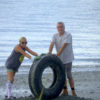 A group from the Citadel led by Dr. John Weinstein was studying microplastics at Charleston Harbor, South Carolina in 2014.
A group from the Citadel led by Dr. John Weinstein was studying microplastics at Charleston Harbor, South Carolina in 2014.
Weinstein and his students were researching microplastics along the harbor. But they found more than what they were expecting. They found plenty of microplastics from broken-down plastic bags. But they reported that the majority of the microplastics in the area were made up of black particles. “More than half of the pieces were black, tubular, and microscopic, with no obvious origins.” They found that these black particles came from a rubber material. These particles must have ended up along the shore as a result of drainage from the streets over time.
This study was one of the first to bring up the issue of microplastic pollution coming from tire wear on the roads.
As we’ve discussed in some of our other blog articles, microplastics are pieces of plastic less than five millimeters in length. These particles are the remains of larger plastic items that have broken down over time. Studies conducted all over the world have given us results on the biggest microplastic pollution that comes from clothing, vehicle tires, bags, and other discarded waste.
For our purposes, we are focusing on the actual pollution caused by tires, and to that end, we would like to educate you a little on what tires are made of and how they are polluting our coastal waterways and tidal marshes.
For thousands of years, wheels were made of stone or wood. Leather was eventually added on top to soften the ride, followed later by solid–rubber “tires”. Cars were invented in the late 1800s, and air-filled rubber tires followed not long after.
At the time, tire rubber came primarily from rubber trees; the cultivation of which has contributed to mass deforestation across the globe. But as the 20th century dawned and cars became less expensive and increasingly common, the world needed more rubber than was readily available. In 1909 German chemist Fritz Hofmann, working for the German chemical company Bayer, invented the first commercial synthetic rubber. Within a year the material was in car tires. By 1931 the U.S. chemical company DuPont had industrialized the manufacturing of synthetic rubber.
Today tires consist of about 19 percent natural rubber and 24 percent synthetic rubber, which is a plastic polymer. The rest is made up of metal and other compounds. Producing tires still has monumental environmental impacts, ranging from continued deforestation to the climate-harming fossil fuels used to make synthetic rubbers to the assembly process. Modern car tires require about 7 gallons of oil to make, while truck tires take 22 gallons.
Biologist, Alexander Turra, claims that marine organisms often consume these pollutant particles. This contaminates their nervous and hormonal systems. But plastics themselves aren’t doing all the harm. Plastics absorb poisonous organic compounds and then, they’re consumed by marine life. This spreads from organism to organism as they eat one another.
The bacteria from plastics hinder their growth, mobility, and reproduction. According to research, America produces 1.8 million tons of microplastics each year from tires. Exactly how much of that waste ends up in waterways depends on many factors.
A report in 2013 explained that light truck tires lose 2.5 pounds worth of rubber over 6 years. Every tire on the planet adds about 2 pounds of rubber into the ocean. According to studies, emissions from tire wear are blown from the street into the air. And these small particles are probably more important in terms of health and ecological consequences. You inhale them and then the small particles could enter your blood vessels.
At the moment, there aren’t many studies on tire pollution and its effects on humans. Airborne microplastics receive less attention than those in rivers and oceans. This is mainly because they’re small and difficult to detect when in the air.
Over time, tire residue in the air begins to settle on our roads, mountains, and rivers. When it rains, these microplastics are pushed through gutters and into the ocean.
Studies have found microplastics harming the digestive system of marine life. This affects small and large organisms from plankton to sharks and whales.
One study cites that microplastics transfer from one organism to another. Scientists refer to this process as trophic transfer. In this study, one-third of mackerels eaten by seals contained microplastics. So, microplastics consumed by smaller organisms appear in larger marine predators.
At the moment tire wear is not regulated. According to Tire Technology International, a way to reduce tire pollution is to create high-quality tires. This includes drivers keeping their tires inflated to the correct PSI. This reduces the amount of wear and tear.
Another possible solution is a redesign of tires. One study found a way to produce rubber from natural sources instead of fossil fuels. In 2019, Goodyear released a new tire concept with moss in the middle, designed to soak up carbon dioxide.
The number of studies towards the improvement of tire production is growing. However, studies show that reducing tire wear would affect performance metrics, resulting in tires with less traction. This would be difficult for manufacturers, as tires may not be as safe if the design changes.
Weinstein concluded from his study that road maintenance may be the best way to tackle this problem. This way the quality of cars doesn’t deter. He suggested making road surfaces more abrasive to reduce tire wear particles. Another solution Weinstein suggests is to collect tire runoff from roads.
Wounded Nature-Working Veterans has become increasingly aware of tire and microplastic pollution. We combat this problem by cleaning up our critical coastal waterways and tidal marshes. We work together to clean microplastics from our waters, and, by continuing to do so, we know we are saving our marine and wildlife populations.
Wounded Nature-Working Veterans has been working to clean our critical coastal waterways and tidal marshes for over ten years. Please see our Past Accomplishments page to view our efforts.
We rely on you to help support our mission. Please take a moment to go to our Support page to see how you can help us make a real environmental difference.
